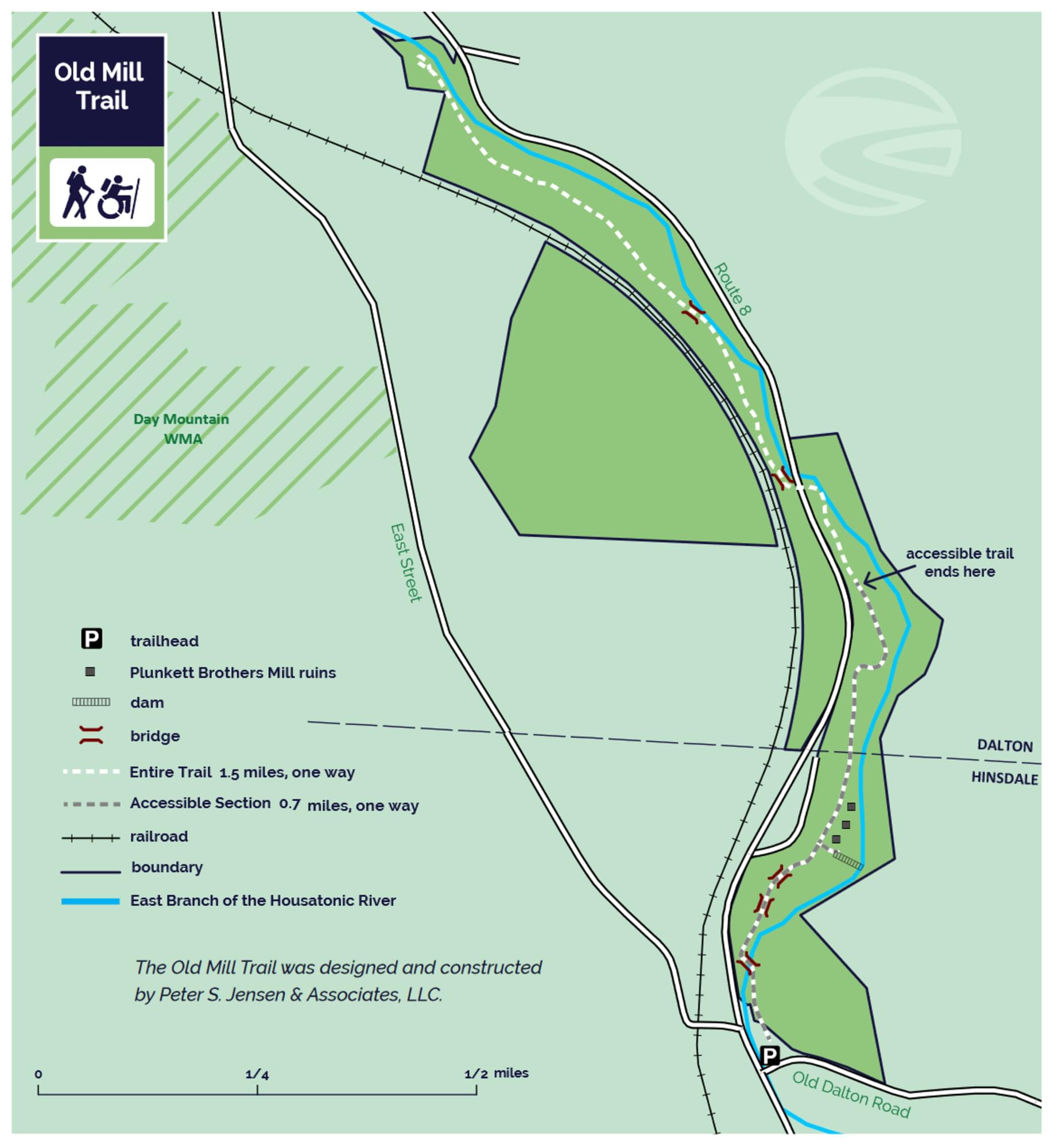Old Mill Trail (BNRC)
Old Mill Trail (BNRC)
Berkshire Natural Resources Council Old Dalton Road Hinsdale, Massachusetts 01235
Official WebsiteOld Mill Trail map
About this Location
The Old Mill Trail of 127 acres is your best way to get to the upper reaches of the Housatonic River. Crane and Company conserved the land with MassWildlife and collaborated with the Housatonic Valley Association to build the trail. The Housatonic River suffers image problems due to PCB contamination south of Pittsfield, but the East Branch is clean and fast-flowing as it descends from Hinsdale. This accessible trail is a treat for trail users of all abilities. Travel past the end of the accessible section and across MA-8 for a pathway right at, and even in, the water’s edge.
This land, and all of the present-day Berkshires, are the ancestral homeland of the Mohican people who were forcefully displaced to Wisconsin by European colonization. These lands continue to be of great significance to the Stockbridge-Munsee Mohican Nation today
The Old Mill Trail was an idea that came out of an East Branch Stream Assessment in 1999. Over 10 years and multiple grants, the Housatonic Valley Association (HVA) coordinated the design and construction of the Old Mill Trail with support from the property owner, Crane & Company, and MassWildlife. Many volunteers worked to lay out the trail from 2000 – 2009. Final construction was completed in 2010 with funding support from the Natural Resources Damages Fund and the skill of Peter S. Jensen & Associates, LLC, professional trail crew builders. BNRC acquired the land in 2016.
The Housatonic River has a rich history. Native Americans used this area for fishing and hunting for about 10,000 years. The Mahicans, who were the last tribe to live here, called the Housatonic River, Hoo-es-ton-nuc- “the place beyond the mountains.” However, disease, wars, and the European demand for land ownership gradually forced the Native Americans out of the area.
European settlement began in earnest after the end of the French and Indian War in 1759. Early settlers harnessed the river’s swift current for water power. Ruins of many mills are all that remain along the riverbank, including a breached dam, stone foundations, and remnants of an impressive penstock—the channel that conveyed water to the mill.
Visitors and residents alike are drawn to the Housatonic River because of its natural beauty and recreational opportunities. The 149-mile river begins its journey to Long Island Sound with its three headwater branches. The East, West, and Southwest Branches meet in Pittsfield to form the main stem of the Housatonic River.
The plants growing along the trail include Hemlock trees that prefer moist, cool ravines near the water. The shade they provide encourages the growth of shrubs such as hobblebush, with white flowers in spring. Cottonwoods, ash, willow, and silver maple along with shrubs such as honeysuckle and gray-stemmed dogwood tolerate the floodplain environment.
The plant communities create specific wildlife habitats. Barred owls and red squirrels, chickadees, and brown creepers favor groves of evergreens. Songbirds such as song sparrows share the floodplain with voles, hawks, and muskrats. Other wildlife, such as mink, coyote, bear, deer, and pileated woodpeckers can be seen in many riverside habitats.
Notable Trails
The first 0.7 miles of the Old Mill Trail is an accessible trail that follows the river north. After the accessible trail ends, the single-track Old Mill Trail continues for 0.8 miles, crossing MA-8 and following the river downstream. After the MA-8 crossing, the first several hundred feet of beautifully crafted trail is at the river’s edge. The entire trail, out-and-back, is 3 miles and offers great views of the East Branch of the Housatonic River.
This trail connecting the communities of Dalton and Hinsdale blends nature’s beauty with the history of the local nineteenth-century textile mills.
There is also an interpretive trail that was installed by the Housatonic Valley Association, which highlights the natural history and mill history.
Features
Restrooms on site
Wheelchair accessible trail
Entrance fee
Content from Official Website
Last updated November 24, 2023
